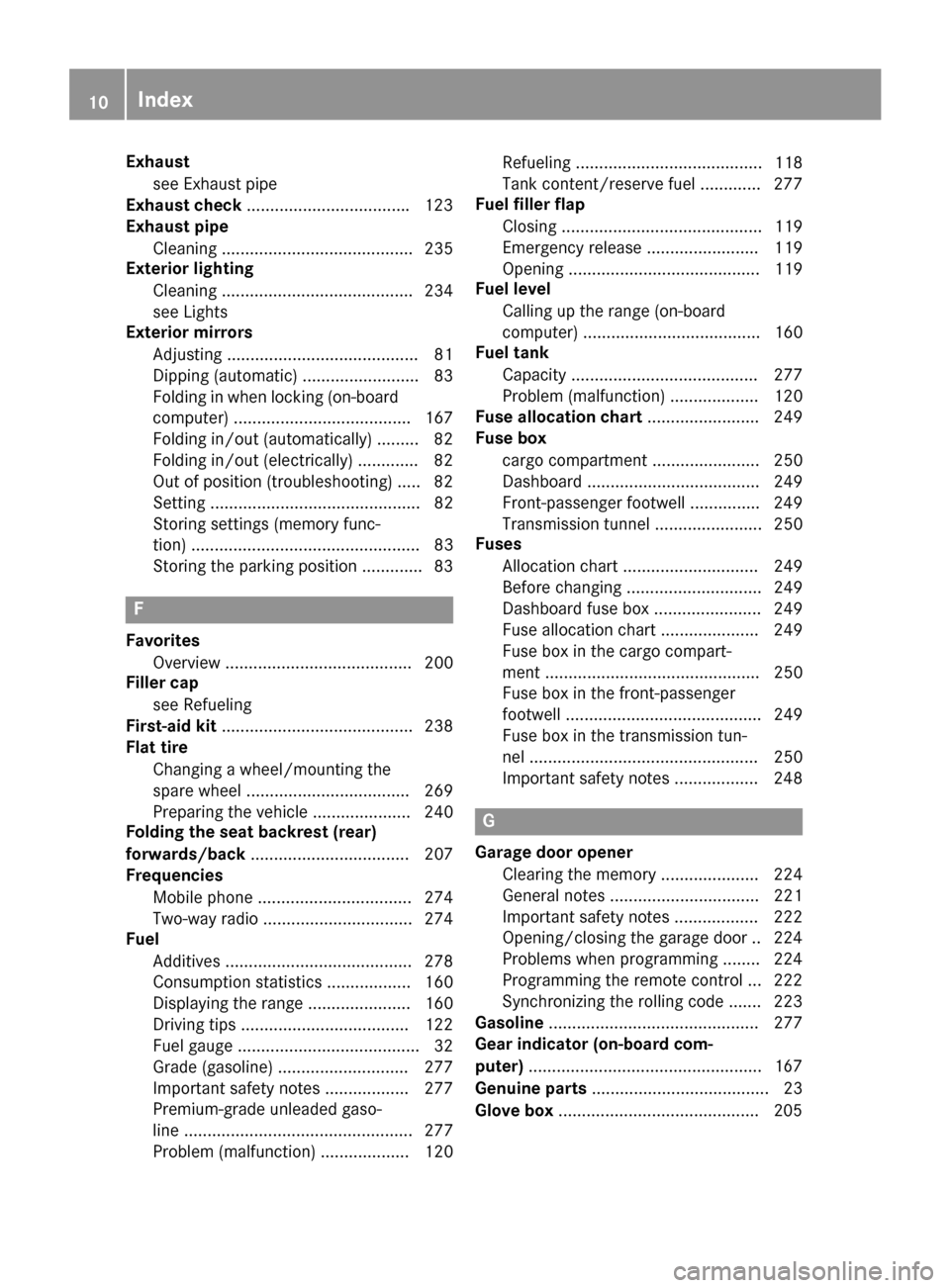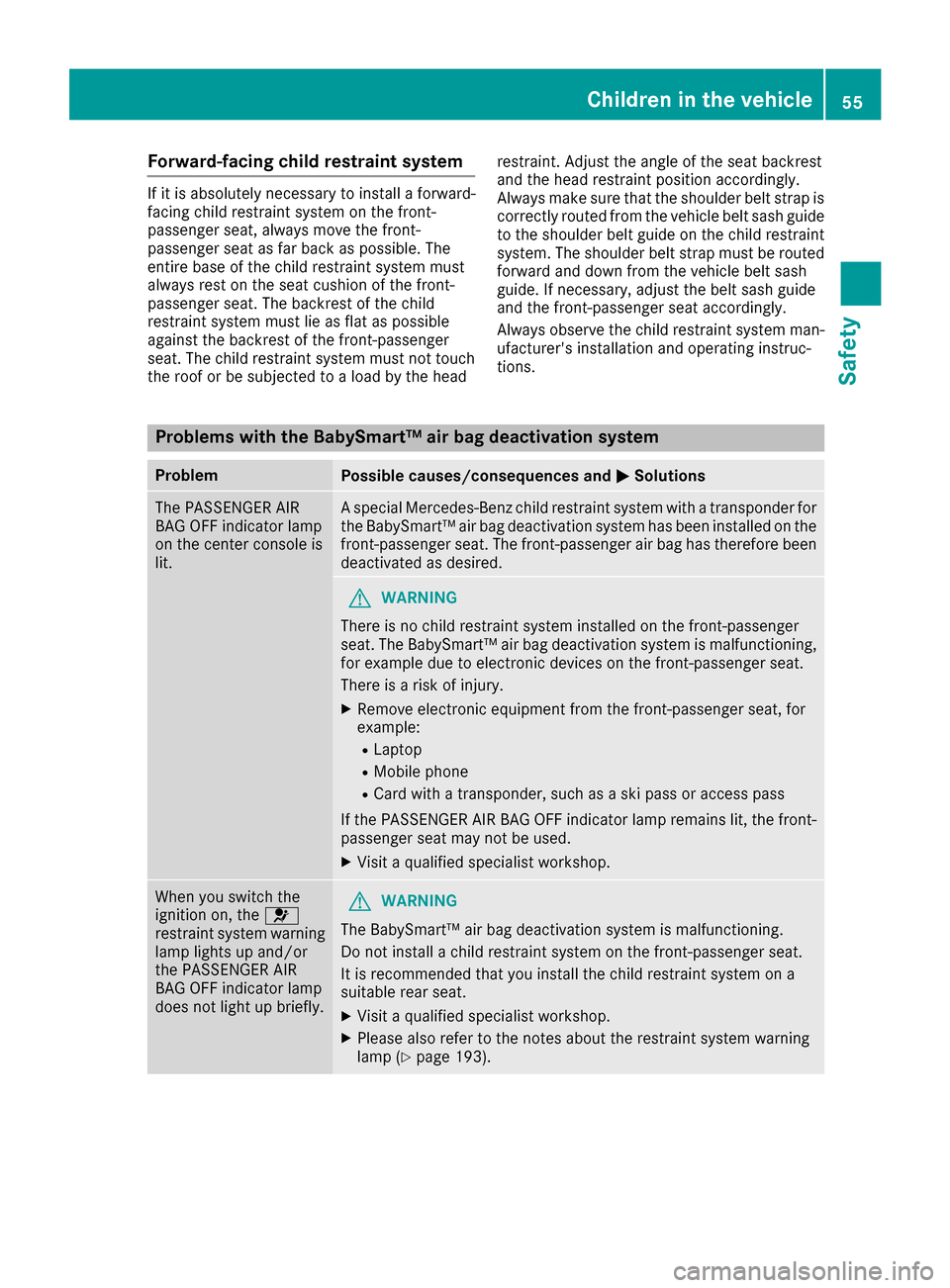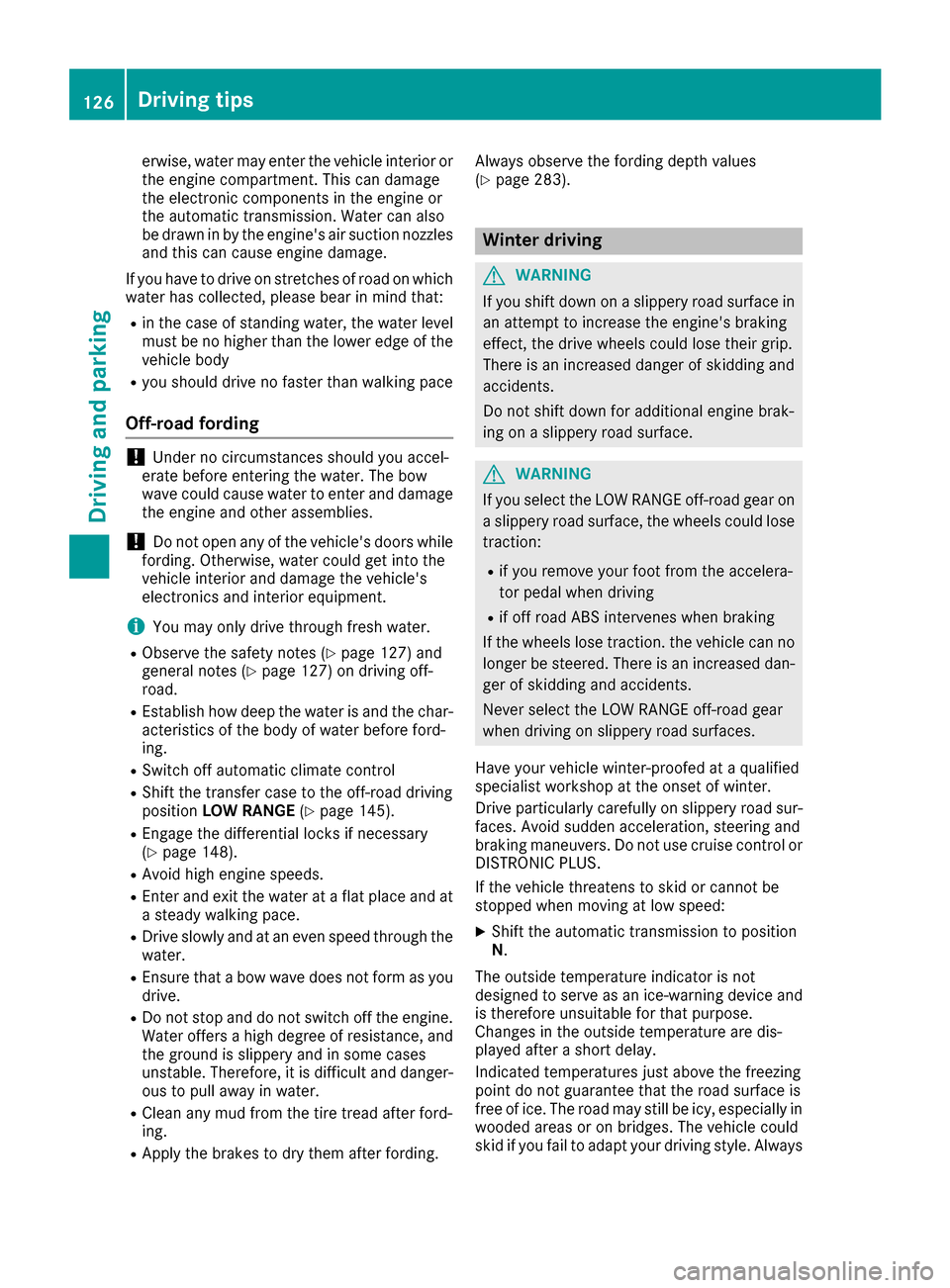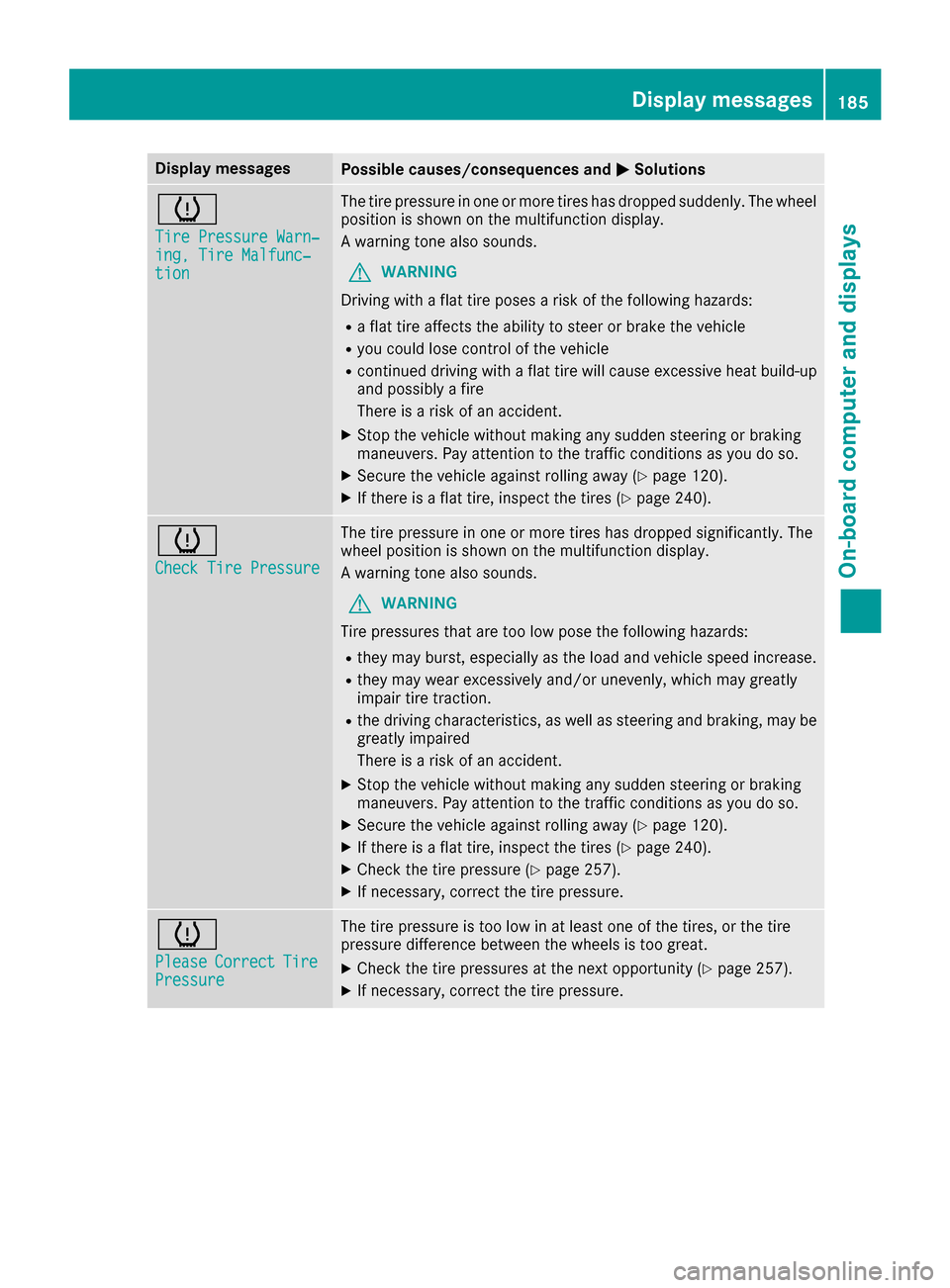2017 MERCEDES-BENZ G-Class flat tire
[x] Cancel search: flat tirePage 5 of 286

Maintenance and care......................225
Engine compartment ........................... 225
Maintenance ........................................ 230
Care ..................................................... 231
Breakdown assistance .....................238
Where wil lIfind...? .............................. 238
Flat tire ................................................ 240
Battery (vehicle) .................................. 241
Jump-starting ....................................... 243
Towing and tow-starting ...................... 246
Fuses ...................................................2 48
Wheels and tires............................... 251
Important safety notes ........................ 251
Operation ............................................ 251
Winter operatio n.................................. 252
Tire pressure ....................................... 254
Loading the vehicle .............................. 260
All about wheels and tires ................... 263
Changing awheel ................................ 269
Wheela nd tire combinations ...............2 73
Technical data................................... 274
Information regarding technical data ... 274
Vehicle electronics .............................. 274
Identification plates .............................2 75
Service products and filling capaci-
ties ...................................................... 276
Vehicle data ......................................... 281
Vehicle data for off-roadd riving .......... 283
Trailer tow hitch ................................... 284
Contents3
Page 12 of 286

Exhaustsee Exhaust pipe
Exhaust check .................................. .123
Exhaus tpipe
Cleaning ......................................... 235
Exterior lighting
Cleaning ......................................... 234
see Lights
Exterior mirrors
Adjusting ......................................... 81
Dipping (automatic) ......................... 83
Folding in whe nlocking (on-board
computer) ...................................... 167
Folding in/out( automatically). ........ 82
Folding in/out (electrically) ............. 82
Outofp osition (troubleshooting )..... 82
Setting ............................................. 82
Storing settings (memory func-
tion) ................................................. 83
Storing the parking position ............. 83
F
Favorites
Overview ........................................ 200
Filler cap
see Refueling
First-aidk it......................................... 238
Flat tire
Changing awheel /mounting the
spare wheel. .................................. 269
Preparing the vehicl e..................... 240
Folding the seat backres t(rear)
forwards/back .................................. 207
Frequencies
Mobil ephone ................................. 274
Two-way radio ................................ 274
Fuel
Additives ........................................ 278
Consumption statistics .................. 160
Displaying the rang e...................... 160
Driving tip s.................................... 122
Fue lgauge ....................................... 32
Grade (gasoline )............................ 277
Important safety notes .................. 277
Premium-grade unleade dgaso-
line ................................................. 277
Problem (malfunction) ................... 120 Refueling ........................................ 118
Tank content/reserve fue
l............. 277
Fue lfille rflap
Closing ........................................... 119
Emergency release ........................ 119
Opening ......................................... 119
Fue llevel
Calling up the rang e(on-board
computer) ...................................... 160
Fue ltank
Capacity ........................................ 277
Problem (malfunction) ................... 120
Fus eallocatio nchart ........................ 249
Fus ebox
cargo compartment ....................... 250
Dashboard ..................................... 249
Front-passenger footwell ............... 249
Transmission tunne l....................... 250
Fuses
Allocation chart ............................. 249
Before changing ............................. 249
Dashboard fus ebox ....................... 249
Fus ealloc ation chart ..................... 249
Fus ebox in the carg ocompart-
ment .............................................. 250
Fus ebox in the front-passenger
footwell .......................................... 249
Fus ebox in the transmission tun-
nel ................................................. 250
Important safety notes .................. 248
G
Garaged ooro pener
Clearing the memory ..................... 224
Generaln otes ................................ 221
Important safety notes .................. 222
Opening/closing the garag edoor..2 24
Problems whe nprogramming ........2 24
Programming the remote control ... 222
Synchronizing the rolling code ....... 223
Gasoline ............................................. 277
Gear indicator (on-board com-
puter) ..................................................1 67
Genuine parts ...................................... 23
Glove box ...........................................2 05
10Index
Page 57 of 286

Forward-facingchild restrain tsystem
If it is absolutely necessar ytoinstal laforward-
facing child restrain tsystem on th efront -
passenger seat ,always mov ethe front-
passenger seat as far bac kaspossible. The
entire base of th echild restrain tsystem must
always res tontheseat cushion of th efront -
passenger seat .The backrest of th echild
restrain tsystem must lie as flat as possible
against th ebackrest of th efront-pa ssenger
seat .The child restrain tsystem must no ttou ch
th er ooforbes ubjected to aload by th ehead restraint
.Adjus tthe angle of th eseat backrest
and th ehead restraint position accordingly.
Always mak esure that th eshoulder belt strap is
correctly routed from th evehicl ebelt sash guide
to th eshoulder belt guide on th echild restrain t
system. The shoulder belt strap must be routed
forward and down from th evehicl ebelt sash
guide .Ifnecessary, adjust th ebelt sash guide
and th efront-pa ssenger seat accordingly.
Always observ ethe child restraint system man -
ufacturer' sinstallation and operating instruc-
tions.
Problemsw ith theBabySmart ™air bag deactivation system
ProblemPossible causes/consequences and MSolutions
The PASSENGER AIR
BA GO FFindicator lamp
on th ecente rconsol eis
lit .As pecial Mercedes-Ben zchild restrain tsystem wit hatransponder for
th eB abySmart ™air bag deactivation system has been installed on th e
front-passenger seat .The front-passenger air bag has therefor ebeen
deactivated as desired .
GWARNING
Ther eisnoc hild restrain tsystem installed on th efront-pa ssenger
seat .The BabySmart ™air bag deactivation system is malfunctioning ,
for example due to electronic device sonthefront-passenger seat .
Ther eisar iskofi njury.
XRemove electronic equipmen tfromt hefront-passenger seat ,for
example:
RLaptop
RMobile phon e
RCard withatransponder ,suc hasas kipass or access pass
If th ePASSENG ER AIRBAG OFFindicator lamp remains lit ,the front-
passenger seat may no tbeused.
XVisitaqualified specialist workshop.
When you switch th e
ignition on ,the 6
restrain tsystem warning
lamp lights up and/o r
th eP ASSENG ER AIR
BA GO FFindicator lamp
does no tligh tupb riefly.GWARNIN G
The BabySmart ™air bag deactivation system is malfunctioning .
Do no tinstal lachild restraint system on th efront-pa ssenger seat .
It is recommended that you instal lthe child restraint system on a
suitable rear seat .
XVisitaqualified specialist workshop.
XPleas ealso refer to th enotes about th erestraint system warning
lamp (Ypage 193).
Children in th evehicle55
Safety
Z
Page 124 of 286

XTo apply:pull parking brake lever ;up
firmly.
Whe nthe ignition is switched on, the F
(US Aonly) or J(Canada only) indicator
lamp in the instrument cluster lights up.
XTo release: pull parking brake lever ;
slightly.
XPress release button :and guid eparking
brake ;down to the stop.
The F (USAonly) or !(Canada only)
indicator lamp in the instrument cluster goes
out.
The vehicl ecan also be braked during an emer-
genc ybyu sing the parking brake.
XTo brake in an emergency: press and hold
release button :and carefull ypullp arking
brake lever ;upwards.
If yo udrive on we troads or dirt-covered surfa-
ces, roads alta nd/or dirt could get into the
parking brake.
In order to prevent corrosion and areduction in
the braking powe rofthe parking brake, observe
the following:
Rpull the parking brake up with release but-
ton :depressedf rom time to time before
beginning ajourney.
Rdrive for approximately1 10 yds(100 m) at a
maximu mspeed of 12 mph (20 km/h)
Parking the vehicle for alon gp eriod
If yo uleave the vehicl eparked for longer than
fourw eeks, the battery maybed amaged by
exhaustive discharging.
If yo ulea ve the vehicl eparked for longer thans ix
weeks, the vehicl emaysuffer damage as a
resul toflackofu se.
XVisit aquali fied specialist workshop and seek
advice.
iYo uc an obtai ninformatio nabout trickle
chargers from aquali fied specialist work-
shop.
Driving tips
General driving tips
Important safety notes
GWARNING
If yo uswitch off the ignition whil edriving,
safety-relevant functions are onlya vailable
with limitations, or not at all. Thi scould affect,
for example, the powe rsteering and the brake
boosting effect. Yo uwillr equire considerably
more effort to steera nd brake. There isarisk
of an accident.
Do not switch off the ignition whil edriving.
GWARNING
If yo uoperate mobil ecommunication equip-
ment whil edriving ,you will be distracted from
traffic conditions. Yo ucould also lose control
of the vehicle. There is ariskofana ccident.
Onlyo perate thise quipment when the vehicle
is stationary.
Observe the legalr equirements for the country
in which yo uare driving .Some jurisdictions pro-
hibi tthe driver from using amobilephone while
driving avehicle.
If yo umakeac allw hile driving ,alway suse
hands-free mode. Onlyo perate the telephone
when the traffic situatio npermits. If yo uare
unsure, pull overtoas afel oc ation and stop
before operating the telephone.
Bea rinm ind thatata speed of only30m ph
(approximately50k m/h), the vehiclecovers a
distance of 44 ft (approximately1 4m)per sec-
ond.
Drive sensibly –save fuel
Observe the following tips to save fuel:
XThe tires should always be inflated to the rec-
ommended tire pressure.
XRemove unnecessary loads.
XRemove roof carriersw hen they are not nee-
ded.
XWarm up the engin eatlow engin espeeds.
XAvoid frequenta cceleration or braking.
XHave all servicea nd maintenancework car-
ried out at the specified intervals.
122Driving tips
Driving and parking
Page 128 of 286

erwise, water may enter the vehicle interior or
the engine compartment.This can damage
the electronic component sinthe engine or
the automatic transmission. Water can also
be drawn in by the engine' sair suction nozzles
and this can cause engine damage.
If you have to drive on stretches of road on which
water has collected, please bear in mind that:
Rin the case of standin gwater, the water level
must be no higher than the lower edge of the
vehicle body
Ryou should drive no faster than walking pace
Off-road fording
!Under no circumstances should you accel-
erate before entering the water. The bow
wave could cause water to enter and damage
the engine and other assemblies.
!Do not open any of the vehicle's doors while
fording. Otherwise, water could get into the
vehicle interior and damage the vehicle's
electronics and interior equipment.
iYou may only drive through fresh water.
RObserve the safety notes (Ypage 127) and
general notes (Ypage 127) on driving off-
road.
REstablish how deep the water is and the char-
acteristics of the body of water before ford-
ing.
RSwitc hoff automatic climate control
RShift the transfer case to the off-road driving
position LOW RANGE (Ypage 145).
REngage the differential locks if necessary
(Ypage 148).
RAvoid high engine speeds.
REnter and exit the water at aflat place and at
as teady walking pace.
RDrive slowly and at an even speed through the
water.
REnsure that abow wave does not form as you
drive.
RDo not stop and do not switch off the engine.
Water offers ahigh degree of resistance, and
the ground is slippery and in some cases
unstable. Therefore, it is difficult and danger-
ous to pull away in water.
RClean any mud from the tire tread after ford-
ing.
RApply the brakes to dry them after fording. Always observe the fordingd
epth values
(
Ypage 283).
Winter driving
GWARNING
If you shift down on aslippery road surface in
an attempt to increase the engine' sbraking
effect, the drive wheels could lose their grip.
There is an increased danger of skidding and
accidents.
Do not shift down for additional engine brak-
ing on aslippery road surface.
GWARNING
If you select the LOW RANGE off-road gear on
as lippery road surface, the wheels could lose
traction:
Rif you remove your foot from the accelera-
tor pedal when driving
Rif off road ABS intervenes when braking
If the wheels lose traction .the vehicle can no
longer be steered. There is an increased dan-
ger of skidding and accidents.
Never select the LOW RANGE off-road gear
when driving on slippery road surfaces.
Have your vehicle winter-proofed at aqualified
specialist workshop at the onset of winter.
Drive particularly carefully on slippery road sur-
faces. Avoid sudden acceleration, steerin gand
braking maneuvers. Do not use cruise control or DISTRONIC PLUS.
If the vehicle threatens to skid or cannot be
stopped when moving at low speed:
XShift the automatic transmission to position
N .
The outside temperature indicator is not
designed to serve as an ice-warning device and is therefore unsuitable for that purpose.
Changes in the outside temperature are dis-
played after ashort delay.
Indicated temperatures just above the freezing
point do not guarantee that the road surface is
free of ice. The road may still be icy, especially in
wooded areas or on bridges. The vehicle could
skid if you fail to adapt your driving style. Always
126Driving tips
Driving and parking
Page 185 of 286

Tires
Display messagesPossible causes/consequencesand MSolutions
Tirep ressure willbe displayed afterdrivingaf ewminutes
The tire pressure monitor is measurin gthe tire pressure.
XDriv eon.
The tire pressures appear in the multifunctio ndisplay after yo uhave
been drivin gfor afew minutes.
TirePress.MonitorInoperativeThe tire pressure monitor is faulty.
XVisitaq ualified specialis tworkshop.
TireP ressure Moni‐tor Inoperative NoWheel Sensors
The wheels mounted do not have asuitabl etire pressure sensor .The
tire pressure monitor is deactivated.
XMount wheels with suitabl etire pressure sensors.
The tire pressure monitor is activated automaticall yafter drivin gfor
af ew minutes.
Check TiresThe tire pressure in one or mor etiresh asdropped significantly. The
whee lposit ioni ss hown in the multifunctio ndisplay .
Aw arning tone also sounds.
GWARNING
Tire pressures thata retoo lo wposet he following hazards:
Rtheym ayburst, especially as the load and vehicl espeed increase.
Rtheym aywear excessivel yand/or unevenly, which mayg reatly
impai rtire traction.
Rthe drivin gcharacteristics, as well as steerin gand braking ,maybe
greatl yimpaired
There is ariskofana ccident.
XStop the vehicl ewithou tmaking any sudden steerin gorbraking
maneuvers. Pa yattentio ntothe trafficc onditions as yo udoso.
XSecure the vehicl eagain st rolling away (Ypage 120).
XIf there is aflatt ire ,inspect the tire s(Ypage 240).
XCheck the tire pressure (Ypage 257).
XIf necessary,correct the tire pressure.
Displaymessages183
On-boardc omputer andd isplays
Z
Page 186 of 286

Display messagesPossible causes/consequences andMSolutions
WarningTireM al‐functionThe tire pressur einoneor mor etires has dropped suddenly. The whee l
position is shown in th emultifunction display.
Aw arning tone also sounds.
GWARNIN G
Drivin gwithaf lat tire poses ariskoft hefollowin ghazards :
Raflat tire affects th eabilit ytos teer or brak ethe vehicl e
Ryou could lose control of th evehicl e
Rcontinued drivin gwithaf lat tire will caus eexces sive heat build-up
and possibl yafire
There is ariskofana ccident.
XStop thevehicl ewithout making any sudden steering or braking
maneuvers .Pay attention to th etraffic condition sasyou do so.
XSecur ethe vehicl eagainst rollin gaway (Ypage 120).
XIf there is aflat tire, inspec tthe tires (Ypage 240).
PleaseCorrec tTirePressureThe tire pressur eistoolow in at least on eofthetires ,ort hetire
pressur edifference between th ewheels is to ogreat.
XChec kthe tire pressures at th enexto pportunity (Ypage 257).
XIf necessary, correc tthe tire pressure.
XRestart th etirep ressur emonitor (Ypage 259).
TirePress .Sen‐sor(s) Missin gThere is no signal from th etirep ressur esensor of on eorseveral
wheels. The pressur eoftheaffecte dtired oes no tappear in th emul-
tifunction display.
XHav ethe fault ytirep ressur esensor replace dataqualified special -
ist workshop .
TirePress.Monito rCurrently Unavaila‐ble
Becausethere is interferenc efromas tron gs ource of radi owaves, no
signals from th etirep ressur esensor sare detected. The tire pressur e
monitor is temporarily malfunctioning .
XDrive on.
The tire pressur emonitor restarts automatically as soo nasthe
problem has been resolved.
184Display messages
On-boardc omputer andd isplays
Page 187 of 286

Display messagesPossible causes/consequences andMSolutions
h
TirePressure Warn‐ing,TireM alfunc‐tion
The tire pressur einoneor mor etires has dropped suddenly. The whee l
position is shown on th emultifunction display.
Aw arning tone also sounds.
GWARNIN G
Drivin gwithaf lat tire poses ariskoft hefollowin ghazards :
Raflat tire affects th eabilit ytos teer or brak ethe vehicl e
Ryou could lose control of th evehicl e
Rcontinued drivin gwithaf lat tire will caus eexces sive heat build-up
and possibl yafire
There is ariskofana ccident.
XStop thevehicl ewithout making any sudden steering or braking
maneuvers .Pay attention to th etraffic condition sasyou do so.
XSecur ethe vehicl eagainst rollin gaway (Ypage 120).
XIf there is aflat tire, inspec tthe tires (Ypage 240).
h
Check Tir ePressure
The tire pressur einoneor mor etires has dropped significantly. The
whee lposition is shown on th emultifunction display.
Aw arning tone also sounds.
GWARNIN G
Tir ep ressures that are to olow pos ethe followin ghazards :
Rthey may burst, especially as th eload and vehicl espeed increase.
Rthey may wear excessivel yand/o runevenly, whic hmay greatl y
impair tire traction .
Rthed rivin gcharacteristics ,aswell as steering and braking ,may be
greatl yimpaire d
There is ariskofana ccident.
XStop thevehicl ewithout making any sudden steering or braking
maneuvers .Pay attention to th etraffic condition sasyou do so.
XSecur ethe vehicl eagainst rollin gaway (Ypage 120).
XIf there is aflat tire, inspec tthe tires (Ypage 240).
XChec kthe tire pressur e(Ypage 257).
XIf necessary, correc tthe tire pressure.
h
PleaseCorrec tTirePressure
The tire pressur eistoolow in at least on eofthetires ,ort hetire
pressur edifference between th ewheels is to ogreat.
XChec kthe tire pressures at th enexto pportunity (Ypage 257).
XIf necessary, correc tthe tire pressure.
Display messages185
On-boardc omputer andd isplays
Z